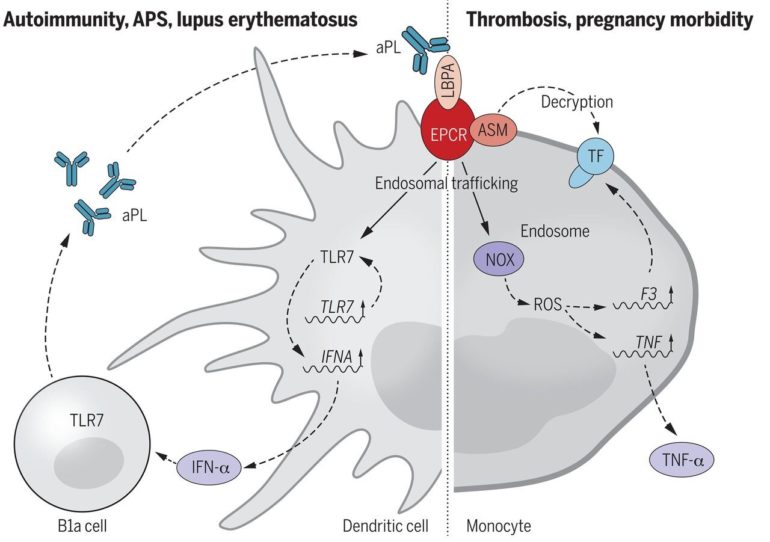A team of researchers affiliated with multiple institutions in Germany and the U.S. have found a cell-surface target for autoantibodies targeting phospholipids (aPL) that contribute to antiphospholipid syndrome (APS). In their paper published in the journal Science, the group describes how they used mouse models of APS with aPL-induced fetal loss and thrombosis to study the connection between the factors that contribute to APS.
APS is an autoimmune disorder that puts patients at an increased risk for a variety of ailments ranging from thrombosis to obstetric complications. It tends to occur in patients experiencing autoimmunity conditions such as lupus. Prior research has led to the discovery of markers that can be used to identify APS in patients but it is still not known why the condition arises. One such marker is an increase in the presence of autoantibodies that target aPLs. Unfortunately, there is also a problem when identifying the underlying reason for an increase in such levels—other circumstances can also lead to them rising as well, such as infectious diseases. In this new effort, the researchers have focused on just the cases where raised levels have been associated with APS. In so doing, they have found a link between coagulation related to a lipid presentation in C receptor links, in APS mouse models.
In studying the endothelial protein C receptor (EPCR) and the way it works with lysobisphosphatidic acid (LBPA), the researchers were able to identify cell-surface targets for aPL and to see how it was internally mediated. More specifically, they found that EPCR served as a cell surface receptor for APLs. They also found that EPCR mediated aPL internalization in certain circumstances. And they found that aPL binding to EPCR-LBPA led to activation of coagulation and the production of interferon-α in dendritic cells. And that led to the creation of more B1a cells, which are the producers of aPL. The researchers found that blocking the EPCR-LBPA binding in the mouse models prevented the chain of events from unfolding which led to a reduction in aPL levels. They suggest this opens the door to the possibility of developing therapies for patients who develop APS.
New research finds ginger counters certain autoimmune diseases in mice
More information:
Nadine Müller-Calleja et al. Lipid presentation by the protein C receptor links coagulation with autoimmunity, Science (2021). DOI: 10.1126/science.abc0956
2021 Science X Network
Citation:
Antiphospholipid syndrome breakthrough: Cell-surface targets identified, opening path to therapies (2021, March 12)
retrieved 15 March 2021
from https://medicalxpress.com/news/2021-03-antiphospholipid-syndrome-breakthrough-cell-surface-path.html
This document is subject to copyright. Apart from any fair dealing for the purpose of private study or research, no
part may be reproduced without the written permission. The content is provided for information purposes only.



